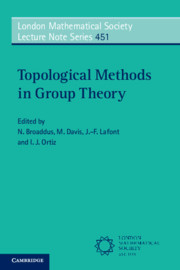Book contents
- Frontmatter
- Contents
- Contributors
- Preface
- 1 Left Relatively Convex Subgroups
- 2 Groups with Context-free Co-word Problem and Embeddings into Thompson’s Group V
- 3 Limit Sets for Modules over Groups Acting on a CAT(0) Space
- 4 Ideal Structure of the C∗-algebra of R. Thompson’s group T
- 5 Local Similarity Groups with Context-free Co-word Problem
- 6 Compacta with Shapes of Finite Complexes: a Direct Approach to the Edwards–Geoghegan–Wall
- 7 The Horofunction Boundary of the Lamplighter Group L2 with the Diestel–Leader metric
- 8 Intrinsic Geometry of a Euclidean Simplex
- 9 Hyperbolic Dimension and Decomposition Complexity
- 10 Some Remarks on the Covering Groups of a Topological Group
- 11 The Σ-invariants of Thompson’s group F via Morse Theory
1 - Left Relatively Convex Subgroups
Published online by Cambridge University Press: 27 August 2018
- Frontmatter
- Contents
- Contributors
- Preface
- 1 Left Relatively Convex Subgroups
- 2 Groups with Context-free Co-word Problem and Embeddings into Thompson’s Group V
- 3 Limit Sets for Modules over Groups Acting on a CAT(0) Space
- 4 Ideal Structure of the C∗-algebra of R. Thompson’s group T
- 5 Local Similarity Groups with Context-free Co-word Problem
- 6 Compacta with Shapes of Finite Complexes: a Direct Approach to the Edwards–Geoghegan–Wall
- 7 The Horofunction Boundary of the Lamplighter Group L2 with the Diestel–Leader metric
- 8 Intrinsic Geometry of a Euclidean Simplex
- 9 Hyperbolic Dimension and Decomposition Complexity
- 10 Some Remarks on the Covering Groups of a Topological Group
- 11 The Σ-invariants of Thompson’s group F via Morse Theory
Summary
Let G be a group and H be a subgroup of G. We say that H is left relatively convex in G if the left G-set G/H has at least one G-invariant order; when G is left orderable, this holds if and only if H is convex in G under some left ordering of G. We give a criterion for H to be left relatively convex in G that generalizes a famous theorem of Burns and Hale and has essentially the same proof. We show that all maximal cyclic subgroups are left relatively convex in free groups, in right-angled Artin groups, and in surface groups that are not the Klein-bottle group. The free-group case extends a result of Duncan and Howie. More generally, every maximal m-generated subgroup in a free group is left relatively convex. The same result is valid, with some exceptions, for compact surface groups. Maximal m-generated abelian subgroups in right-angled Artin groups are left relatively convex. If G is left orderable, then each free factor of G is left relatively convex in G. More generally, for any graph of groups, if each edge group is left relatively convex in each of its vertex groups, then each vertex group is left relatively convex in the fundamental group; this generalizes a result of Chiswell.
- Type
- Chapter
- Information
- Topological Methods in Group Theory , pp. 1 - 18Publisher: Cambridge University PressPrint publication year: 2018

